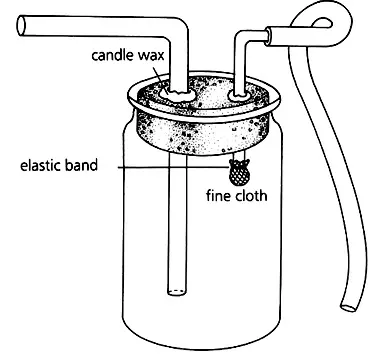Question 1
Define parasitology as a branch of biology
Answer
Parasitology is the study of parasites
Question 2
Define biotechnology as a branch of biology
Answer
Biotechnology is a branch of biology that deals with development of techniques for application of biological processes (use of biological processes/organisms/systems) to manufacture products intended to improve the quality of human life.
Question 3
State why respiration is essential in organisms:
Answer
Respiration provides cells with energy they need to carry out the various life processes.
Question 4
Name the apparatus below and state its function

Answer
a) This is a pooter.
b)This is used for sucking small animals from rock surfaces or barks of trees.
b)This is used for sucking small animals from rock surfaces or barks of trees.
Question 5
What is binomial nomenclature?
Answer
Giving an organism two scientific names which are made up of the genus and species names
Question 6
The scientific name of a rat is Rattus norvegicus.
(i) Write the name correctly
(ii) Identify the generic name
Answer
(i) Rattus norvegicus or Rattus norvegicus
(ii) Rattus
(ii) Rattus
Question 7
The leg of a wasp was magnified 3 times using the hand lens. If the length of the drawing that the student made measured 6 cm, what was the actual length of the leg?
Answer
Working
Magnification = Drawing length ÷ Actual length
= 6 cm ÷ 3
= 2 cm
Hint: Remember to include the units of measurements.
Magnification = Drawing length ÷ Actual length
= 6 cm ÷ 3
= 2 cm
Hint: Remember to include the units of measurements.
Question 8
Why is classification important?
Answer
- It makes it easier to identify an organism
- It is easier to describe an organism as it is based on characteristics of the organism
- Large number of organisms is divided into smaller groups depending on characteristics
- The whole world uses the same groupings, so that everyone understands each other
Question 9
Define species in biology.
Answer
A species is a group of closely related organisms that can reproduce naturally (freely) to produce a fertile (viable) offspring
Question 10
State 4 characteristics of viruses
Answer
- They are on the boundary between living and non-living organisms
- Each type of virus will only infect only certain types of cells; they are highly specific to their hosts
- They can only reproduce by invading living cells
- They have simple structure with small piece of nucleic acid of RNA of DNA
Question 11
In a class experiment to establish the size of an onion cell, you observed the cell's field of view through a microscope.
On observation, you counted 20 cells across the diameter of this field of view. Assume that the diameter of field of view is 3mm. Calculate the size of one cell in micrometers.
Answer
Working
Cell size = Diameter of field of view (micrometers) ÷ Number of cells along the diameter of field of view
Since 1000µm = 1 mm
= 1000 x 3 = 3000 µm
= 3000µm ÷ 20
= 150µm
Hint: Remember to include the units of measurements (µm).
Cell size = Diameter of field of view (micrometers) ÷ Number of cells along the diameter of field of view
Since 1000µm = 1 mm
= 1000 x 3 = 3000 µm
= 3000µm ÷ 20
= 150µm
Hint: Remember to include the units of measurements (µm).
Question 12
While observing a specimen using the high power objective, you discovered that the image was not clear. Which part of the microscope can you use to get a sharp image?
Answer
Fine adjustment knob
- The fine adjustment knob raises or lowers the body tube for smaller distance to bring the image into sharper focus. It is mostly used with high-power objective lens.
- The fine adjustment knob raises or lowers the body tube for smaller distance to bring the image into sharper focus. It is mostly used with high-power objective lens.
Question 13
A cell was magnified 800 times using a light microscope whose eye piece was x20. What was the magnification of the objective lens?
Answer
X40
Working
= 800 ÷ 20
= X40
Working
= 800 ÷ 20
= X40
Question 14
Provide an explanation for why it is necessary to stain microscope specimens.
Answer
To make structures more clear
Question 15
Explain the importance of maintaining moisture on microscope specimens.
Answer
To make cells turgid (prevent dehydration)
Question 16
What is cell specialization?
Answer
Cell specialization is when newly formed cells undergo structural modifications to perform a specific function.
Question 17
The diagrams below show a red blood cell that was subjected to a certain treatment.

a. Identify the state of the cell at the end of the experiment
b. Account for the shape of the cell at the end of the experiment.
Answer
a. Haemolysed
b. The cell was placed in hypotonic solution (e.g distilled water). The cell gained water molecules by osmosis which made it swell and burst.
b. The cell was placed in hypotonic solution (e.g distilled water). The cell gained water molecules by osmosis which made it swell and burst.
